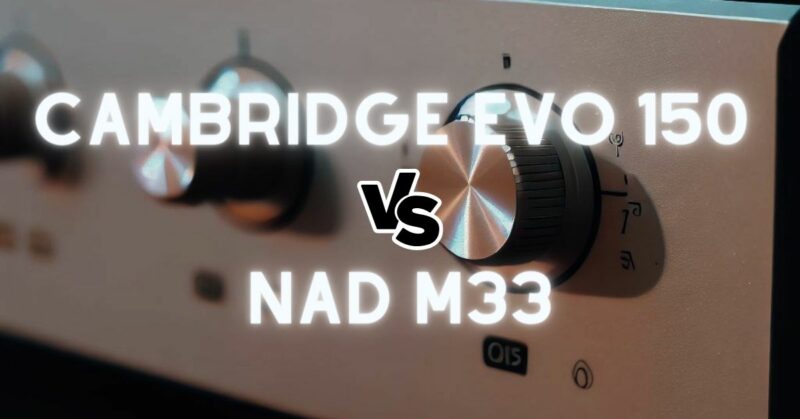When it comes to high-end integrated amplifiers, the Cambridge Audio Evo 150 and the NAD M33 are two exceptional options that stand out from the crowd. Both models offer impressive features and performance, making it difficult to choose between the two. In this article, we’ll compare the Cambridge Evo 150 and the NAD M33 to help you decide which one is the right fit for your needs.
Design and Build Quality
Both the Cambridge Evo 150 and the NAD M33 have a modern and minimalist design. The Evo 150 has a sleek aluminum front panel with a large color LCD display, while the M33 has a matte black finish with a small color LCD display. Both models come with a remote control for convenient operation.
In terms of build quality, both amplifiers are solidly built with high-quality materials. The Evo 150 has an aluminum casing with a thick front panel and a large heatsink on the back, while the M33 has a durable steel chassis with an aluminum front panel. Overall, both amplifiers have a premium feel and are built to last.
Features
The Cambridge Evo 150 and the NAD M33 are packed with features that make them highly versatile and convenient to use. The Evo 150 has a built-in DAC that supports high-resolution audio up to 32-bit/384kHz and DSD256, along with a wide range of connectivity options including Bluetooth, Wi-Fi, AirPlay 2, and Chromecast. It also has a built-in phono stage for vinyl enthusiasts and supports Roon Ready for seamless music streaming.
The NAD M33, on the other hand, has a built-in BluOS streaming module that offers access to various music streaming services, including Spotify, Tidal, and Qobuz. It also has a high-quality DAC that supports hi-res audio up to 32-bit/384kHz and DSD256. In addition, the M33 has a range of connectivity options, including Bluetooth, Wi-Fi, and AirPlay 2, as well as HDMI eARC for easy connection to your TV.
Performance
When it comes to sound quality, both the Cambridge Evo 150 and the NAD M33 deliver exceptional performance that will satisfy even the most discerning audiophiles. The Evo 150 has a power output of 150 watts per channel and uses Cambridge Audio’s proprietary Class G amplification technology, which ensures high efficiency and low distortion. The Evo 150 also has a dedicated subwoofer output and can be configured to drive two sets of speakers independently.
The NAD M33, on the other hand, has a power output of 200 watts per channel and uses NAD’s Hybrid Digital Purifi Eigentakt amplification technology, which delivers high power with extremely low distortion. The M33 also has a dedicated subwoofer output and can be configured to drive two sets of speakers independently.
Both amplifiers offer impressive sound quality that is clear, detailed, and well-balanced across the entire frequency range. The Evo 150 has a slightly warmer and more laid-back sound signature, while the M33 has a more neutral and transparent sound signature.
Price
The Cambridge Evo 150 and the NAD M33 are both high-end amplifiers that come with a premium price tag. The Evo 150 retails for around $4,000, while the M33 is priced at around $5,500. While the Evo 150 is more affordable, it still offers exceptional performance and features that are on par with the more expensive M33.
Conclusion
Overall, both the Cambridge Audio Evo 150 and NAD M33 are excellent choices for those looking for a high-quality, all-in-one streaming system. They both offer a range of features, great sound quality, and sleek designs. Ultimately, the choice between the two will come down to personal preference and the specific needs of the user.
If you value the ability to fine-tune your sound, the NAD M33 may be the better choice with its built-in Dirac room correction and advanced parametric EQ. It also has a more powerful amplifier and a larger number of inputs, making it a more versatile choice for those who need to connect multiple devices.
On the other hand, if you’re looking for a more compact and stylish system that still delivers excellent sound quality, the Cambridge Audio Evo 150 is a great option. It offers a simpler and more intuitive user interface, as well as a sleek, minimalist design that will look great in any room.
Ultimately, both of these systems represent the very best in all-in-one streaming technology and are excellent choices for those looking to streamline their home audio setup without sacrificing sound quality. Whether you choose the NAD M33 or the Cambridge Audio Evo 150, you can rest assured that you’ll be getting a high-quality product that will provide years of listening pleasure.

